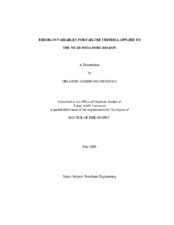| dc.description.abstract | The development of a methodology to improve the parametric representation of the failure criteria used to characterize rock strength of a reservoir rock in the near-wellbore region is the focus of this study. We adopted a statistical method, so-called error-in-variables (EIV), to take into account experimental errors in all of the measured variables. The proposed methodology is employed to obtain the parameters of the failure envelope (2D criteria) from experimental data in the following cases:
When the experimental data are used directly to determine the failure envelope in the Mohr plane. When a failure envelope is first obtained in the principal-stress plane and then transformed into the Mohr plane using Computer Algebra. When the presence of pore fluid requires the consideration of effective stresses. When the brittle-ductile transition requires special form of the envelope (cap models) Using generalization of previously developed methods, we employed EIV methods to obtain the parameters of a failure surface in the principal-stress space (3D criteria).The basic hypothesis of this work is that the EIV method provides a better representation of failure criteria than the previous methodology. The basic application of any failure criterion is to determine whether a certain stress state will or will not lead to failure. A parametric representation is considered better than another if the likelihood of obtaining the wrong answer is less than in the other case. Therefore, the best representation (within a certain family of envelopes or surfaces) is the one minimizing the objective function, which is nothing else but the likelihood of this wrong answer. To test the basic hypothesis of this work, I compared the objective function (likelihood of erroneous decision) calculated with parametric representations obtained by various methods. To achieve this I evaluated a well-documented, published set of experimental data, for which failure envelopes have been fitted by other methods. This work is limited to the processing of data obtained in experiments conducted in homogenous, isotropic rock at isothermal conditions. Sedimentary rocks such as sandstone are the focus of this study because of their importance in near-wellbore reservoir rock stability problems. Nevertheless, the methodology developed in this work is not limited to this type of rock. | en |


